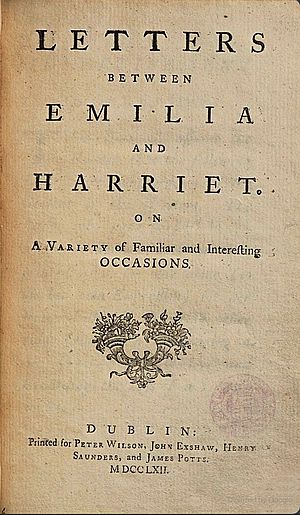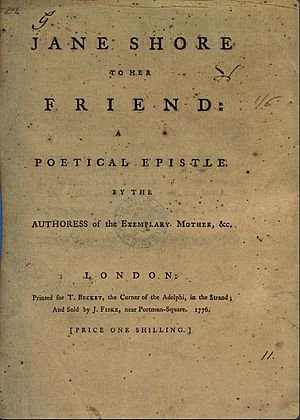Maria Susanna Cooper facts for kids
Quick facts for kids
Maria Susanna Cooper
|
|
|---|---|
| Born | Maria Susanna Bransby 20 August 1737 Shotesham, Norfolk, England |
| Died | 3 July 1807 (aged 69) Dursley, Gloucestershire, England |
| Pen name | "A lady"; "the authoress of" |
| Occupation | novelist; poet |
| Years active | c. 1750—1784 |
| Notable work | The Exemplary Mother (1769) |
| Spouse | Samuel Cooper |
| Children | Robert Bransby Cooper (son); Astley Cooper (son) |
| Relatives | Bransby Blake Cooper (grandchild) |
|
|
|
Maria Susanna Cooper (born Bransby, 1737–1807) was an English writer. She wrote novels, children's books, and poems. She is best known for her novels written as letters. Her stories often taught lessons about how daughters, wives, and mothers should act.
Contents
Maria Susanna Cooper's Life Story
Maria Susanna Bransby was born on August 20, 1737. Her hometown was Shotesham in Norfolk, England. Her parents were James Bransby and Anna Maria Paston.
In 1761, she married Samuel Cooper. He became a church leader in Yelverton, but they stayed in Shotesham for 20 years. In 1781, the Cooper family moved to Great Yarmouth.
Maria Susanna Cooper's Family
Maria Susanna Cooper had ten children with her husband.
- Robert Bransby Cooper (1762-1845)
- Samuel Lovick Cooper (1763-1817)
- William Howman Cooper (1764-1834)
- Charlotte Maria Anna Inyon Cooper (1765-1786)
- Marianne (Cooper) Spurgeon (c. 1765 -1789)
- Astley Paston Cooper (1768-1841)
- Anna Maria Cooper (1770-1770)
- Margaret Bransby Cooper (1772- c. 1783)
- Beauchamp Newton Cooper (1774-1802)
- Anne Maria Inyon Cooper (1777-1793)
Sadly, some of her children passed away young. Her second child, Samuel Lovick Cooper, became a clergyman. Her son Astley Cooper became a famous surgeon and anatomist. Astley Cooper also inspired his nephew, Bransby Blake Cooper, to become a surgeon.
Maria Susanna's husband, Samuel, died in 1800. In 1806, she moved to Dursley, Gloucestershire. She lived with her oldest son, Robert Bransby Cooper, who was a politician. She passed away there on July 3, 1807.
Maria Susanna Cooper's Writing Career
Maria Susanna Cooper started her writing career by creating children's books. These were published with John Newbery, a famous publisher. However, details about these early books are not well known today.
She is most famous for her epistolary novels. These are novels written as a series of letters. Her first one was Letters between Emilia and Harriet (1762). Her most well-known work is The Exemplary Mother, or Letters between Mrs. Villars and her Family. This book came out in two parts in 1769. A new version was published in 1784.
Connecting with Other Writers
Even though she was a clergyman's wife, Maria Susanna Cooper was part of a larger group of writers. Her name often appeared on lists of people who supported other novelists' books. She was also a good friend of novelist Elizabeth Bonhote. Elizabeth Bonhote even dedicated her book Darnley Vale to Cooper in 1789.
In 1775, Cooper published two more novels. These were The Daughter and The History of Fanny Meadows. The next year, she published a poem called Jane Shore to her Friend: A Poetic Epistle.
After she died, her son Robert Cooper managed her writings. He re-published her novels in new versions. He also published two other works. These were Moral Tales (1811), a collection of short stories, and a novel called The Wife, or, Caroline Herbert (1813).
Why She Wrote Anonymously
Maria Susanna Cooper's early books were published without her name. Even after she became successful, her books were often credited to "the author of The Exemplary Mother". She did start signing her introductions later on. It was common for women writers during this time to keep their authorship a secret. This helped them keep a reputation for being modest.
Her son, Robert Bransby Cooper, wrote about her reasons for writing. He said she wanted to entertain and teach her children. He also said she felt it was her duty. Cooper's novels definitely aimed to teach lessons. But they also tried to show real, believable characters.
Maria Susanna Cooper's Published Works
- Letters between Emilia and Harriet (London and Dublin, 1762).
- The exemplary mother: or, letters between Mrs. Villars and her family (London and Dublin, 1769; 2nd ed. 1784).
- The daughter: or the history of Miss Emilia Royston, and Miss Harriet Ayres (London and Dublin, 1775).
- The history of Fanny Meadows (London 1775; Dublin 1776).
- Jane Shore to her friend: a poetical epistle (London, 1776).
- The Wife; or, Caroline Herbert (London, 1813).
Online Versions of Her Books
You can read some of Maria Susanna Cooper's books online:
- Letters Between Emilia and Harriet (1762) (Full text, Google; Full text, HathiTrust)
- Jane Shore to Her Friend (1776) (Full text, Google)
- The Wife (1813) (PDF, Chawton House)



